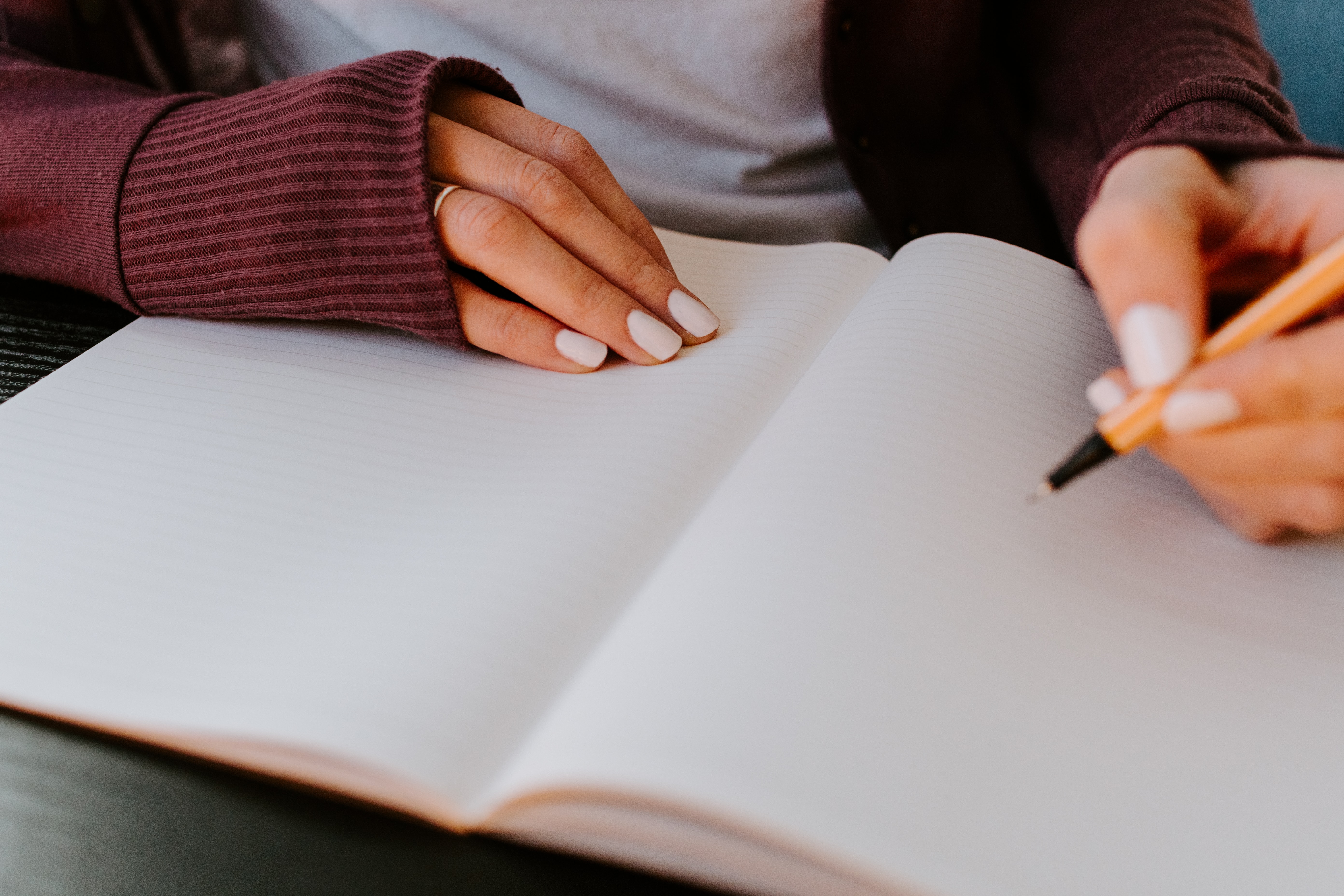Stream of consciousness writing can help focus your mind
Overwhelmed with anxiety and muddled thoughts? It's World Wellbeing Week, so we asked business psychologist Paula Gardner about the technique she swears by to find help focus and boost creativity


Overwhelmed with anxiety and muddled thoughts? It's World Wellbeing Week, so we asked business psychologist Paula Gardner about the technique she swears by to find help focus and boost creativity
As psychologists warn that the fallout from the coronavirus pandemic could have a profound impact on our mental wellbeing, it's now more than ever that we should be doing whatever we can to ameliorate these effects. As mental health professionals raise concerns about the toll this crisis is taking, the Office of National Statistics (ONS) reported nearly half of adults in the UK have suffered from anxiety problems because of the pandemic.
According to a government survey, 47 % of people had reported 'high levels' of anxiety, while over four in five of people (84%) said they were worried about the effect the virus is having on their life, and 53% said it was affecting their well-being.
So if you're feeling overwhelmed, like you 'can never think straight', or your brain is foggy or muddled then in these unprecedented times it's hardly surprising, But how can you help yourself start to think clearly and help lower your anxiety levels?
Well, one thing that can really help is a method of writing that became fashionable in the early 20th century, a style adopted by distinguished authors such as James Joyce and Virginia Woolf: it’s known as stream of consciousness. You don’t have to be a literary heavyweight to take this on, honestly anyone can do it. And stream of consciousness writing is excellent for helping stop all that rumination (thinking the same thoughts over and over again), for getting some focus into your thinking, and it’s even good for inspiring creativity.
What is stream of consciousness writing?
In novels and stories it’s a style of writing that basically allows us to see characters’ thoughts as they come up: unedited, messy and all over the place. It feels disorganised and disordered, but also truly authentic – because it’s how humans actually think. The term 'stream of consciousness' was first used by psychologist William James to describe writing that was a flow: unedited, and raw. The idea is that you write whatever comes into your mind, as it happens. A typical example might be: 'I’ve got to stop talking to Helena that way, it only puts her on edge, I can tell, and it never works but My body feels so heavy and I have no energy and maybe it’s because I haven’t been swimming for at least a month because of this lockdown oh it’s Ben’s birthday on Saturday, that will be great to see everyone on Zoom, maybe Helena will be online we can have a chat…' Applied to ourselves, it’s a way for us to get our thoughts out of our heads and down onto paper. Yes, it seems messy and all over the place, but the true value is what stream of consciousness writing can do for us.
1. It helps us sort out problems
By letting our mind flow, uninterrupted and unedited, we basically give it the freedom to sort out issues, a bit like a psychoanalyst who just nods and doesn’t say anything. You may well veer off track and start thinking of what's for lunch or what's dropping on Netflix, but in the meantime the mind is thinking about what you said and may go back to the subject with another thought or even solution. According to this neuro science study getting your worries out of your head and onto paper frees up your brain to think about the things that matter. It makes some cognitive space so you can concentrate on the task in hand. The other side effect is that this also reduces stress and anxiety at the same time. You may also notice that patterns or certain issues crop up again and again. The very fact of spotting them may be enough to move them to resolution. If not, writing around and on those topics in this free form way may help.
Celebrity news, beauty, fashion advice, and fascinating features, delivered straight to your inbox!
2. It’s good for us
Stream of consciousness can provoke feelings of “flow”, something Positive Psychologist Mihály Csíkszentmihályi said promoted feelings of health and wellbeing. Flow happens when you’re completely absorbed in an activity. Time falls away and you lose focus on everything else. This provokes a release of dopamine, making us feel happy. Unlike the happiness we feel through our relationships or downing a G&T, we can access this happiness whenever we want and with no side effects. Flow is also associated with higher self-esteem and more resilience.

3. It promotes creativity
If you’d like to be more creative, you can do the same exercise but make it more fictional, perhaps writing a stream of consciousness around a something you can see out of your window or a fictional party. Writing, unedited and with no intention other than to get the words out, frees up the mind. There is no judgement, no writing for anyone else’s eyes. It is liberating. If you really want to engage the right-hand, creative side of the brain, try writing with your non-dominant hand. There has been research that suggests that when we use our dominant hand, as we do most of the time, we are mainly using one hemisphere of our brain. However, when we move to our non-dominant hand, it provokes us to use two hemispheres, promoting new thinking and creativity.
How to do stream of consciousness
There is no wrong or right way. You can dip in when you need it, or create a daily habit. You can do it in a dedicated notebook, or just use plain paper. You can use a biro, fountain pen or even coloured felt pens. The four rules are: 1. To get the best out of this, do it by hand. It’s the physical mind-to-hand activity that stimulates the brain and gets it working. 2. Practise no judgement. Even if you spend all your time writing about the fact you want some cake but can’t because you’ve given up cake, it doesn’t matter. 3. Give yourself a target. This could be three pages of A4, or a time limit of 20 minutes. Experiment and see how long/much you need to write to get you into the flow and feel a benefit. 4. You can save the writing and look through it later, or chuck it out. The advantage of the latter is that you don’t have to worry about your handwriting. When I do mine, I literally don’t take my hand off the page so all my words run together. I find this helps me write faster and keep up with my brain. Stream of consciousness can be powerful, but it can also be hugely enjoyable. Try it for yourself at least three or four times to see what it can do for you.
* This article originally appeared on audreyonline.co.uk, the online platform for women who need advice on how to make a restart and generally living more audaciously. Paula Gardner, business psychologist and career coach can be found at Scarlet Thinking for personal consultations and coaching.
Maria Coole is a contributing editor on Marie Claire.
Hello Marie Claire readers – you have reached your daily destination. I really hope you’re enjoying our reads and I'm very interested to know what you shared, liked and didn’t like (gah, it happens) by emailing me at: maria.coole@freelance.ti-media.com
But if you fancy finding out who you’re venting to then let me tell you I’m the one on the team that remembers the Spice Girls the first time round. I confidently predicted they’d be a one-hit wonder in the pages of Bliss magazine where I was deputy editor through the second half of the 90s. Having soundly killed any career ambitions in music journalism I’ve managed to keep myself in glow-boosting moisturisers and theatre tickets with a centuries-spanning career in journalism.
Yes, predating t’internet, when 'I’ll fax you' was grunted down a phone with a cord attached to it; when Glastonbury was still accessible by casually going under or over a flimsy fence; when gatecrashing a Foo Fighters aftershow party was easy-peasy-lemon-squeezy and tapping Dave Grohl on the shoulder was... oh sorry I like to ramble.
Originally born and bred in that there Welsh seaside town kindly given a new lease of life by Gavin & Stacey, I started out as a junior writer for the Girl Guides and eventually earned enough Brownie points to move on and have a blast as deputy editor of Bliss, New Woman and editor of People newspaper magazine. I was on the launch team of Look in 2007 - where I stuck around as deputy editor and acting editor for almost ten years - shaping a magazine and website at the forefront of body positivity, mental wellbeing and empowering features. More recently, I’ve been Closer executive editor, assistant editor at the Financial Times’s How To Spend It (yes thanks, no probs with that life skill) and now I’m making my inner fangirl’s dream come true by working on this agenda-setting brand, the one that inspired me to become a journalist when Marie Claire launched back in 1988.
I’m a theatre addict, lover of Marvel franchises, most hard cheeses, all types of trees, half-price Itsu, cats, Dr Who, cherry tomatoes, Curly-Wurly, cats, blueberries, cats, boiled eggs, cats, maxi dresses, cats, Adidas shelltops, cats and their kittens. I’ve never knowingly operated any household white goods and once served Ripples as a main course. And finally, always remember what the late great Nora Ephron said, ‘Everything is copy.’
